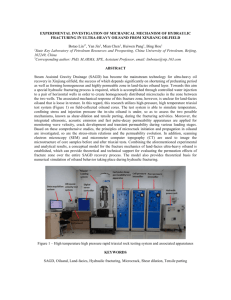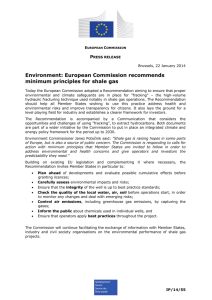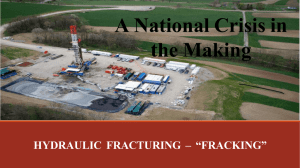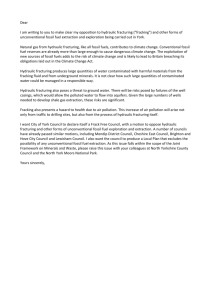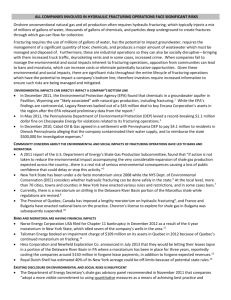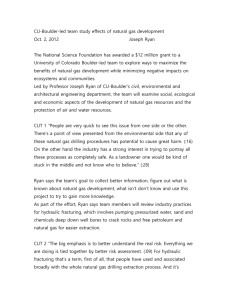The Underground Injection Control Program and Summary of EPA
advertisement
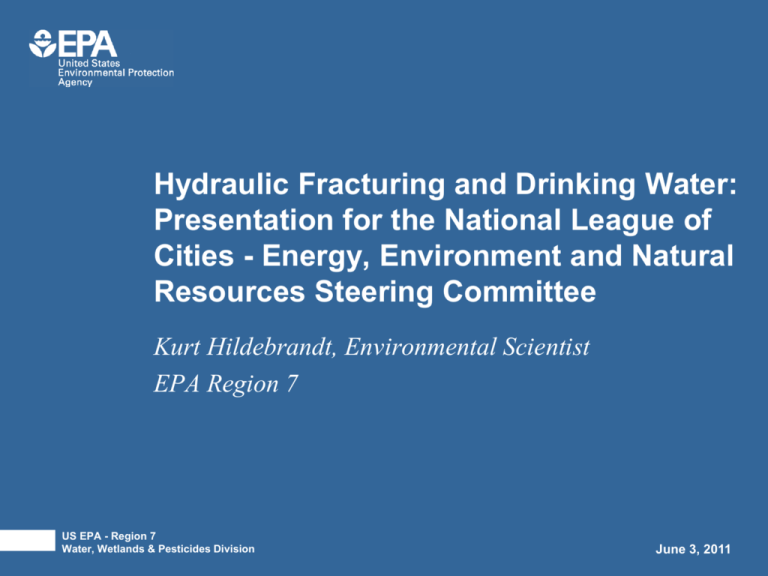
Hydraulic Fracturing and Drinking Water: Presentation for the National League of Cities - Energy, Environment and Natural Resources Steering Committee Kurt Hildebrandt, Environmental Scientist EPA Region 7 US EPA - Region 7 Water, Wetlands & Pesticides Division June 3, 2011 Preface Hydraulic fracturing (HF) was first used over 100 years ago in 1903, but the first commercial fracturing treatment to stimulate oil and gas production was performed in 1947/48. In fact, one of the first – if not the first – application of HF for enhanced oil and gas production occurred in Kansas in 1947. Since that time, HF has been applied more than one million times to stimulate production in old wells and enhance production process in unconventional formations and unfavorable locations. 2 Natural Gas Extraction • Natural gas is an abundant domestic source of energy – Power generation, cooking and heating, transportation, fertilizer production, and other uses • Electricity production using natural gas produces less CO2 emissions on a BTU basis than coal or oil • Application of hydraulic fracturing and horizontal drilling has enabled economic extraction of gas from shale formations deep below the surface – Rapid expansion across the U.S. – International growth 3 Gas Well Field 4 Where Are We Today? • Shale gas is produced in 20 states across the country • Approximately 35,000 gas wells were fractured in 2010 • Many inactive gas wells are being looked at as candidates for fracturing • Significant growth projected: Energy Institute of America’s (EIA) Outlook 2011 report estimates doubling of recoverable shale gas • International interest – France, Great Britain, Germany, Poland, Australia, and others 5 Importance of Shale Gas 2008 Proved Reserves (trillion ft3) 2009 Proved Reserves (trillion ft3) Coalbed Methane 20.8 18.6 Shale 34.4 60.6 Conventional & Tight 199.9 204.7 Total 255.0 283.9 Source of Gas 6 Major Shale Gas Plays in the United States 7 Well Drilling • Well drilling may be vertical or horizontal • Horizontal drilling is a new technology frequently used in less permeable formations such as shale to increase production Several wells using horizontal drilling may extend radially into a formation from a central wellpad, unlike vertical wells Vertical (left) and horizontal drilling (right) with HF crosssection of well 8 Production Well Construction 9 Injection Well Construction 10 What is Hydraulic Fracturing? • • • 11 Hydraulic fractures are created when a fluid is pumped down production wells at high pressure for short periods of time (hours) The high-pressure fluid exceeds the rock strength and opens fractures in the rock A propping agent, usually sand, is pumped into the fractures to keep them from closing when the fracturing pressure is released Hydraulic Fracturing Schematic 12 Highly Industrialized Process 13 Typical Wellpad Arrangement 14 What is in Hydraulic Fracturing Fluid? Typically, the fluids used in hydraulic fracturing are water-based and contain: – – – – – – – 15 Biocides Fluid-loss agents Friction reducers Surfactants Acids Petroleum distillates Proppants How Can HF Impact Sources of Drinking Water? • Potential endangerment of water supplies – New and different geographic and geologic settings – Adjacent formations may contain metals, radionuclides, salts, or other constituents that may be mobilized and impact water quality • Environmental contaminants associated with hydraulic fracturing chemicals, well drilling, water, wastes, and residuals may pose risks to public health, water resources, and the environment 16 How Can HF Impact Sources of Drinking Water? (cont.) • Sustainability of water resources – Sources used for HF come from public water sources, or directly from ground or surface waters – Average well water usage for production is order of magnitude higher than conventional gas production • Shale Gas - 2,000,000-6,000,000 gal. vs. CBM 50,000-350,000 gal. of water (not including proppant and/or additive volume) 17 Overview of Regulatory Authorities • States hold authority to regulate most oil and gas production activities • State and local governments have siting authorities • Federal authorities limited, but do exist, under a variety of statutes administered by different agencies, e.g.: – SDWA, CWA, CAA – NEPA – Endangered Species Act 18 Safe Drinking Water Act Authorities • SDWA requires EPA to protect drinking water sources from contamination caused by underground injection • • EPA UIC Program established six classes of wells (Classes I – VI) Class II wells inject fluids associated with oil and natural gas production including: – Fluids brought to the surface in connection with natural gas storage operations, or conventional oil or natural gas production (e.g., produced water) – For enhanced recovery of oil or natural gas (e.g., well stimulation) – For the storage of liquid hydrocarbons (usually as part of the US Strategic Petroleum Reserve) • • 19 UIC programs may not interfere with or impede production activities SDWA also contains emergency powers to address imminent and substantial endangerment UIC Program Implementation • 20 33 states have primary enforcement authority (primacy) for the UIC program; EPA and states share program implementation in 7 states and 2 tribes; EPA directly implements the entire UIC Program in 10 states Energy Policy Act 2005 • EPA’s 2004 coal bed methane study of hydraulic fracturing found no confirmed cases of contamination, but highlighted that diesel could be an area of concern • Congress revisited SDWA definition of “underground injection” and exempted hydraulic fracturing, except when diesel fuel is used [Section 1421(d)(1)(B)]: – (i) the underground injection of natural gas for purposes of storage; and – (ii) the underground injection of fluids or propping agents (other than diesel fuels) pursuant to hydraulic fracturing operations related to oil, gas or geothermal production activities • EPA is developing guidance to answer questions about the permitting process for diesel fuels in HF fluids 21 Overview of EPA’s Role • Responsible development of America’s shale gas resources offers important economic, energy security, and environmental benefits • EPA plays an important role in addressing public concerns, ensuring environmental protection, and in working with federal and state partners to manage the benefits and risks of shale gas production • The Agency is committed to improving scientific understanding of the potential environmental impacts of shale gas extraction and using tools at hand to address any known concerns 22 Concerns Raised by the Public and Others • Flammable tap water; explosive conditions in the home from methane • Drinking water contamination from HF chemicals • Stream and river water quality impacts • Livestock deaths attributed to water contamination from HF fluids • Unknown chemicals in HF fluids injected into ground water • Gas well blowouts, air emissions and fluid spills • Seismicity in Arkansas 23 Overall Reaction/Response • Industry and state oil and gas agencies are beginning to respond to concerns, but in some cases, the public may question conflicts of interest • State permitting processes for oil and gas vary in their effectiveness, depending on how recently they were updated – Some states have limited ability to enforce – AL, AR, CO, NM, LA, OH, WY recently changed regulations • NY and localities in TX, MD have some form of moratorium • Civil suits in PA, NY and TX • Vigorous press and Congressional attention 24 EPA’s Overall Approach on Shale Gas – Best Design and Management Practices • President Obama’s Blueprint for a Secure Energy Future (March 2011) – Working with Secretary of Energy’s Advisory Board to develop recommendations to minimize adverse impacts to public health and the environment from shale gas production, and to inform regulatory development www.whitehouse.gov/sites/default/files/blueprint_secure_energy_future.pdf 25 EPA’s Approach in Addressing Hydraulic Fracturing Concerns • Research to improve our understanding of potential impacts, to provide accurate information, and to respond to Congressional requests • Guidance to explain how existing regulations apply • New regulations to update standards where they may be outdated • Coordination and partnerships with external stakeholders • Enforcement to ensure compliance with environmental laws 26 EPA Responses to Hydraulic Fracturing Concerns (partial listing) • • • • • • 27 Series of Public Meetings Information requests to nine hydraulic fracturing companies Office of Research and Development (ORD) Study EPA Region 6 enforcement action in Texas Fort Peck Reservation contamination Working with State of Pennsylvania 2010 Public Meetings 28 2010 Public Meetings Summary Citizens, Communities, Organizations • HF critical to the economic viability of the community • HF poses risks to: • Drinking water • Air • Land • Wildlife • Citizens concerned about undisclosed chemicals in HF fluids • Citizens requested EPA intervention 29 Industry State Regulators • HF has a long history of safety • Industry is willing to share data with EPA to support safety claims • States are best at regulating industry • HF has not been proven to be the cause of contamination • States are adequately regulating • Willing to share data with EPA Information Requests • In the fall of 2010, EPA issued a request to nine hydraulic fracturing companies to voluntarily submit information on hydraulic fracturing for the study • Information requested: – Chemical composition of fracturing fluid products – Data on the health and environmental impacts of the products and constituent chemicals – Detailed information on the hydraulic fracturing process – Sites where the companies have fractured and where they will fracture • Responses were received from all nine but many companies claimed confidentiality on the chemical composition information 30 EPA’s Approach on HF - Scientific Study • Congress asked EPA to study relationship between hydraulic fracturing and drinking water resources • Peer-reviewed study currently underway, with first results due in late 2012 • Lifecycle approach, use of case studies, focus on sources and pathways of potential impacts to water resources • Stakeholder involvement throughout process Serious concerns have also been raised about air quality, impacts on land and aquatic ecosystems, seismic risks, public safety and occupational risks These topics are not within the scope of the current study 31 Study Plan Framework Phases of the Hydraulic Fracturing Study • Water acquisition • Chemical mixing • Well injection • Flowback and produced water • Water treatment and waste disposal 32 Scientific Questions Water Acquisition • How do large volume water withdrawals from ground water and surface water impact drinking water resources? - What are the impacts on water availability? - What are the impacts on water quality? 33 Scientific Questions Chemical Mixing • What are the possible impacts of on-site spills and/or leaks on drinking water resources? - What is the composition of hydraulic fracturing fluids and what are the toxic effects of the constituents? - What factors may influence the likelihood of contamination of drinking water resources? - What practices are used to contain or mitigate spills/leaks? 34 Scientific Questions Well Injection • How might the fracturing process lead to contamination of water resources by hydraulic fracturing chemicals or naturally occurring substances? - How effective are well construction practices at containing fluids during and after fracturing? - What are the potential impacts of pre-existing man-made or natural pathways/features on contaminant transport? - What chemical/physical/biological reactions could impact the mobilization, transport, fate or toxicity of substances in the subsurface? 35 Scientific Questions Flowback and Produced Water • What are the possible impacts of on-site spills and/or leaks on drinking water resources? - What is the composition and variability of flowback and produced water, and what are the toxic effects of these constituents? - What factors may influence the likelihood of contamination of drinking water resources? - What practices are used to contain or mitigate spills and/or leaks? 36 Scientific Questions Water Treatment and Waste Disposal • What are the possible impacts of inadequate treatment of flowback and produced water on drinking water resources? - How effective are treatment and disposal methods? 37 Hydraulic Fracturing Study Timing • 2011: Finalize study plan and conduct research • 2012: Report of Preliminary Results • 2014: Report of Further Results 38 Possible Uses of Research Results • Research will identify key drivers for impacts of hydraulic fracturing activities on drinking water resources • Results may be used by: – Local, state, tribal and federal governments – Communities – Industry – Environmental groups 39 Acronyms • • • • • • • 40 CAA - Clean Air Act CERCLA - Comprehensive Environmental Response, Compensation & Liability Act CWA - Clean Water Act NEPA - National Environmental Policy Act NESHAPs - National Emission Standards for Hazardous Air Pollutants NPDES - National Pollutant Discharge Elimination System NSPS - New Source Performance Standards • • • • • OPA - Oil Pollution Act RCRA - Resource Conservation and Recovery Act SDWA - Safe Drinking Water Act SPCC - Spill Prevention, Control, and Countermeasures UIC - Underground Injection Control Program Other EPA Statutory Authorities Which Could Impact HF Activities In addition to the SDWA, EPA can use existing authorities to prevent contamination from oil and gas production activities. For example: • CWA discharges into publicly-owned treatment works (POTWs) and surface waters • CAA’s New Source Performance Standards (NSPS), National Emission Standards for Hazardous Air Pollutants (NESHAPs), and Mandatory Reporting of Greenhouse Gases • NEPA’s authority to review and comment on federal actions (e.g., leasing on federal lands) 41 Guidance and Regulation Development • CWA: Regulations and guidance for treatment and disposal of production wastewater • SDWA: Guidance to provide framework for use of diesel fuel in hydraulic fracturing fluids • CAA: Proposing air regulations that govern certain activities at well sites • RCRA: Guidance on how to construct proper wastewater pits and impoundments 42 Continuing partnership with states – on the frontlines of regulating this sector Emergency Response Authorities SDWA 1431 order to address imminent and substantial endangerment caused by entry of pollutant into underground source of drinking water SDWA 1431 order to address imminent and substantial endangerment caused by entry of pollutant into public water system CERCLA 104 removal action to address release that may present imminent and substantial endangerment, subject to the “petroleum exclusion” CERCLA 106 order to address imminent and substantial endangerment, subject to the “petroleum exclusion” CAA 303 action to address imminent and substantial endangerment of public health or welfare, or the environment from air emissions or pollution RCRA 7003 action to address solid waste handling that may present imminent and substantial endangerment to health or the environment 43 CWA 504 action to address imminent and substantial endangerment to health, welfare or livelihood caused by discharge from “pollution source” CWA/OPA 311 action to address imminent and substantial threat to public health or welfare from discharges of oil or hazardous substances to navigable waters Find Out More About the UIC Program and Keep Current on the HF Study • EPA Underground Injection Control Website: http://water.epa.gov/type/groundwater/uic/index.cfm • EPA Hydraulic Fracturing Website: http://water.epa.gov/type/groundwater/uic/class2/hydraulicfracturing/index.cfm 44 Questions? EPA REGION 7 - Water, Wetlands and Pesticides Division Drinking Water Management Branch UIC Program (WWPD/DRWM) 901 North 5th Street Kansas City, Kansas 66101 Attention: Kurt Hildebrandt Phone: (913) 551-7413 Fax: (913) 551-9413 e-mail: hildebrandt.kurt@epa.gov 45

